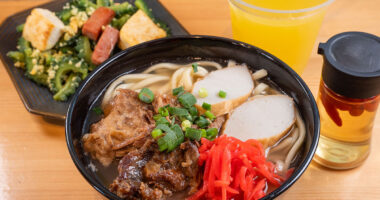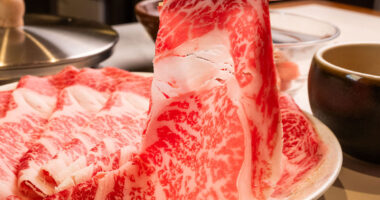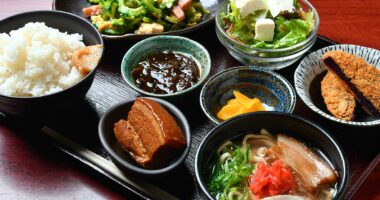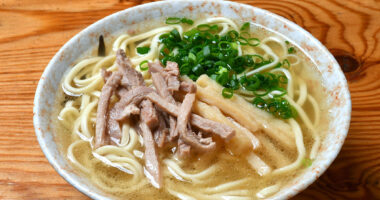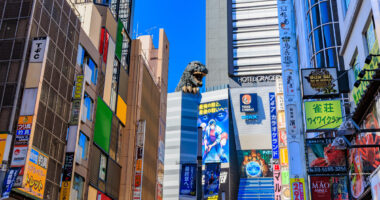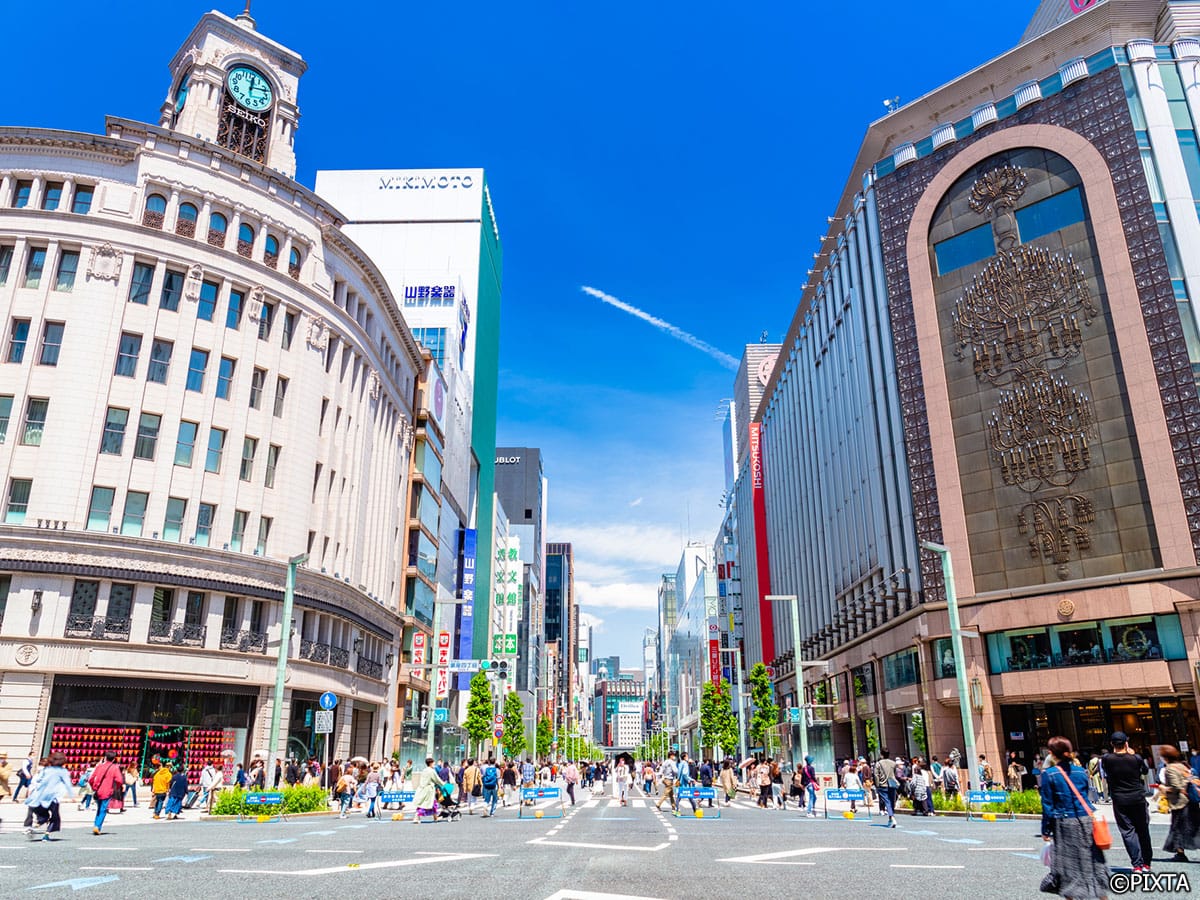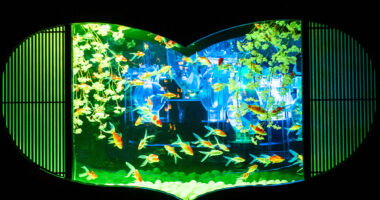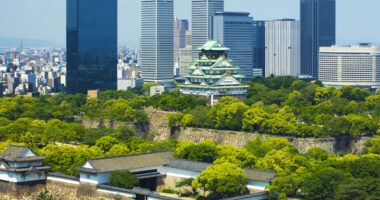- What makes watching kabuki special?
- Best kabuki theaters in Tokyo and Kyoto for international tourists
- How to buy kabuki tickets in Japan
- Timing is everything: understanding kabuki show schedules
- First-time kabuki experience tips for international visitors
- Breaking the language barrier
- Enhancing the experience: Go beyond the show
- A kabuki afternoon in Tokyo: sample itinerary
- Step into the story
Planning to watch Kabuki in Japan? You’re in for an unforgettable cultural experience. Kabuki isn’t just about theater—it’s an invitation into the heart of Japan’s artistic spirit. For first-time visitors, figuring out where and how to watch can feel overwhelming. This guide focuses on practical tips to help you plan, book, and enjoy a Kabuki performance in person.
Related article:
First time learning about Kabuki? You’ll want to read our helpful introduction: “What Is Kabuki? A Beginner’s Guide to Japan’s Traditional Theater.”
What makes watching kabuki special?

Photo for illustration purposes
Unlike traditional plays elsewhere, Kabuki combines stylized acting, rich visuals, and historical themes into a spectacle that bridges the past and present. With rotating stages, walkways through the audience, and live music, Kabuki is immersive from the moment the curtain rises. You don’t have to speak Japanese to enjoy it—many theaters offer subtitle devices or short explanations.
Best kabuki theaters in Tokyo and Kyoto for international tourists
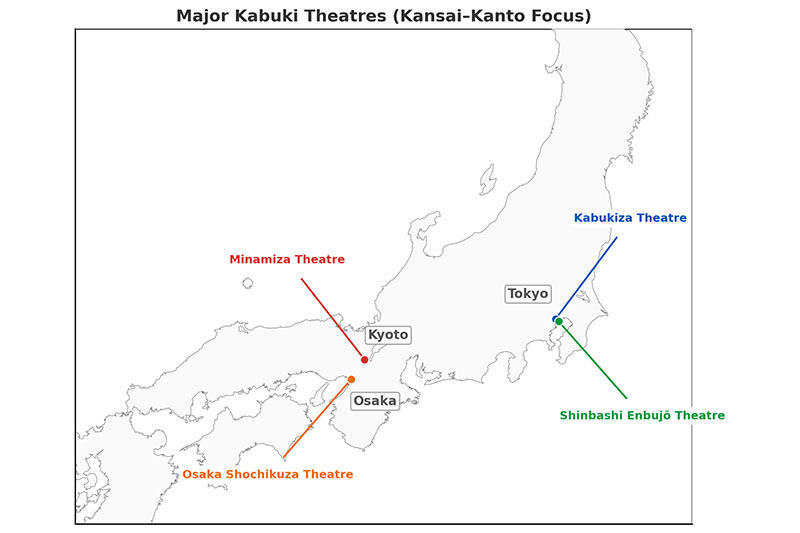
Japan has a number of theaters where Kabuki comes alive, but for most visitors, focusing on the two cultural giants, Tokyo and Kyoto, is a smart choice. These cities not only offer world-class performances but also make the experience more accessible for non-Japanese speakers.
Kabukiza (Tokyo): the crown jewel of kabuki
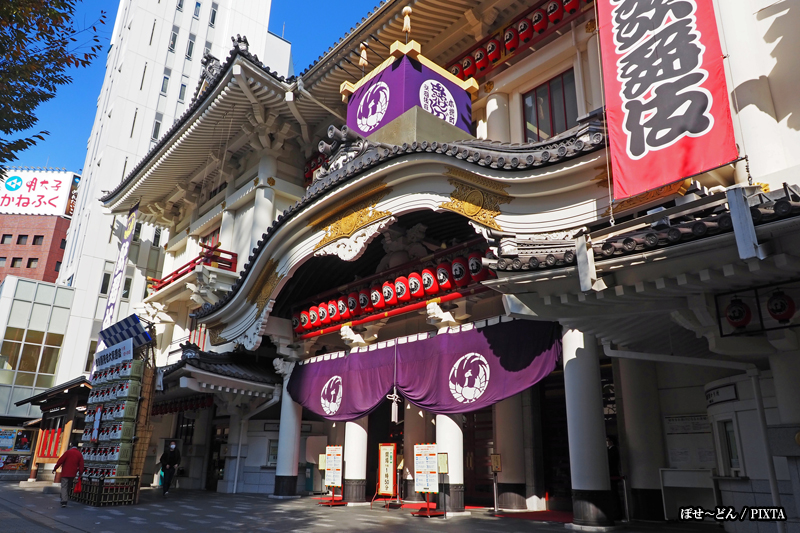
Photo for illustrative purposes
For those searching for the top kabuki theaters in Tokyo and Kyoto for tourists, Kabukiza is number one. Located in the glitzy district of Ginza, Tokyo’s most prestigious Kabuki venue perfectly blends tradition with accessibility.
Once inside, visitors are immediately captivated by the grand red-and-white facade, intricate chandeliers, and a stage that transports you centuries into Japan’s past. With 1,800 seats across four floors, it’s the largest kabuki theater in the world. Performances here happen nearly every month and offer multiple shows throughout the day. So, planning a visit is easy, even if you’re on a tight schedule.
What makes Kabukiza tourist-friendly?
Kabukiza offers traditional architecture, modern amenities, and rotating performances nearly every month. You can buy full tickets or just drop in for a makumi-seki (one act seat), which is ideal if you’re short on time or unsure about committing to a full show.
Here are some of the features of Kabukiza theater:
| Category | Details |
|---|---|
| Location/Access | Located in Ginza, directly connected to Exit 3 of Higashi-Ginza subway station (Hibiya/Asakusa Lines). |
| Language support | Rentable for 1,000 JPY for single acts, 1,500 JPY for full shows (cash only) |
| Vibe/Atmosphere | Prestigious venue blending tradition with accessibility, featuring a grand red-and-white facade and intricate chandeliers. |
| Show information | Performances happen nearly every month with multiple shows daily. |
Insider tip: Arrive early and explore the Kabukiza Gallery on the rooftop to learn more about the art form before the show. There you’ll find displays of props, costumes, and even a mini stage mock-up.
Click here for details and booking for upcoming shows at Kabukiza Theatre.
Shinbashi Enbujo (Tokyo): Where innovation meets tradition

Photo for illustrative purposes
Tucked in Tokyo’s upscale Ginza district, Shinbashi Enbujo is the city’s versatile Kabuki venue, known for staging both classic performances and bold, modern interpretations. Unlike the grand formality of Kabukiza, this theater embraces experimentation, making it perfect for travelers curious about Kabuki’s evolving side.
Why visit Shinbashi Enbujo?
- Fusion-friendly performances: Ideal for newcomers who want a fresh, modern twist on tradition.
- Intimate setting: A slightly smaller venue that brings you closer to the action.
- Prime location: Surrounded by Ginza’s restaurants and shopping, perfect for a cultural-meets-lifestyle evening.
Here’s a quick breakdown of its features:
| Category | Details |
|---|---|
| Location/Access | Located in Ginza. Surrounded by Ginza’s restaurants and shopping. |
| Language support | Varies—check ahead for subtitle devices. |
| Vibe/Atmosphere | Contemporary, experimental, yet rooted in tradition; embraces experimentation. |
| Show information | Stages both classic performances and bold, modern interpretations. |
Check upcoming shows and ticket details here.
Minamiza (Kyoto): a journey through time
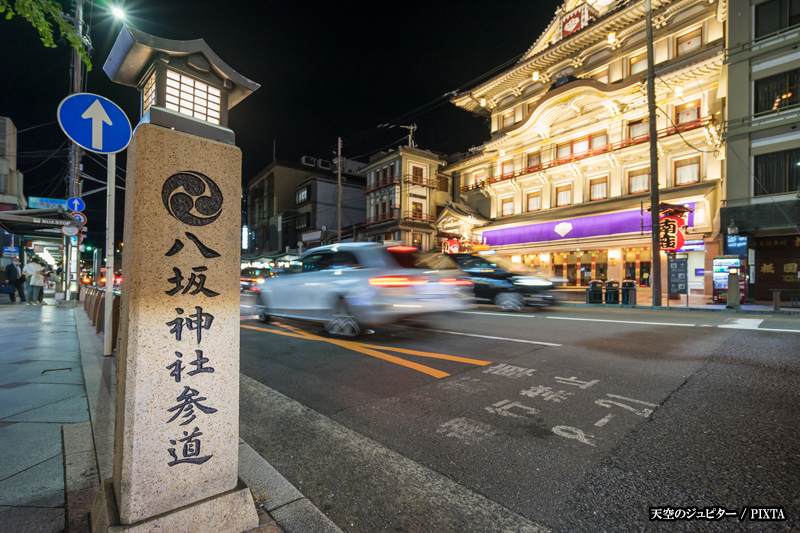
Photo for illustrative purposes
If Kabukiza is the epitome of modern tradition, Minamiza in Kyoto is a walk through living history. Known as one of the oldest Kabuki theaters in Japan, it stands just at the edge of Kyoto’s atmospheric Gion district, home to geishas, tea houses, and cobbled alleys.
A visit to Minami-za is not just a performance; it’s a full sensory journey into Edo-period aesthetics. The theater’s wooden interiors, classic lanterns, and antique seating arrangement give you a genuine feel for what theatergoers experienced centuries ago.
Why is Minamiza a must for travelers?
- Limited but authentic show calendar: Often aligned with seasonal festivals like spring cherry blossoms or autumn leaf viewing.
- Deep cultural immersion: Ideal for travelers who want their theater experience to be uniquely Kyoto.
- Local restaurants and tea houses nearby: Pair your Kabuki evening with a traditional kaiseki meal for the ultimate Kyoto night out.
Here’s a quick breakdown of its features:
| Category | Details |
|---|---|
| Location/Access | A short walk from Exit 6 of Gion-Shijo Station (Keihan Line), located at the edge of Kyoto’s Gion district known for geishas and tea houses. |
| Language support | Limited, but rental guides are sometimes available. |
| Vibe/Atmosphere | Traditional atmosphere in historic Gion; one of the oldest Kabuki theaters in Japan, with wooden interiors and antique seating. |
| Show information | Limited but authentic show calendar, often aligned with seasonal festivals. |
Tip: Minamiza typically holds performances during seasonal events or special festivals, making timing key. Check the calendar well in advance if your trip includes Kyoto.
For upcoming shows’ details and booking, click here.
Bonus venue: Shochikuza Theater in Osaka
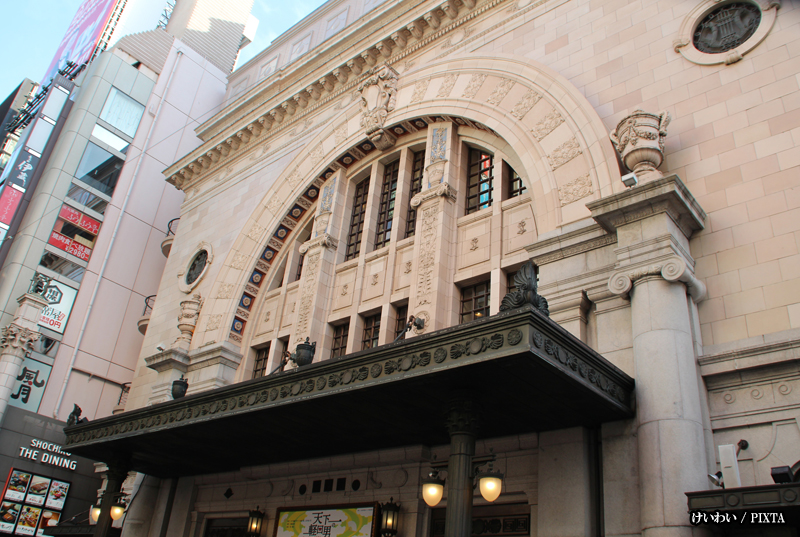
Photo for illustrative purposes
For those venturing beyond Tokyo and Kyoto, Osaka’s Shochikuza Theater in the vibrant Dotonbori district offers a modern yet equally captivating introduction to Kabuki.
The energy in Shochikuza is palpable. With large LED displays on the outside and Osaka’s famed takoyaki stalls just around the corner, it’s perfect for travelers looking to merge tradition with the city’s urban buzz. Thus, it’s great for travelers interested in blending traditional arts with modern city vibes.
Have a quick look at its features with details:
| Category | Details |
|---|---|
| Location/Access | A 3-minute walk from Exit B14 of Namba Station, located in Osaka’s vibrant Dotonbori district. |
| Language support | English subtitles are available (rentable devices, 1,500 JPY). |
| Vibe/Atmosphere | Modern yet captivating; characterized by a lively crowd and blends traditional arts with modern city vibes. |
| Show information | Offers monthly and seasonal performances. |
Check out the details regarding upcoming shows and booking.
How to buy kabuki tickets in Japan
One of the most common challenges faced by travelers is figuring out how to buy Kabuki tickets in Japan. The good news? The process has been streamlined for international visitors.
Let’s see how to get your seat.
Online purchase (recommended)
Buying tickets online is the most convenient way, especially if you want guaranteed seats or prefer English-language navigation.
There are two ways. Either book it from the official Shochiku Kabuki website, which offers both full-performance and single-act tickets, or purchase your tickets from third-party sellers, like Klook, and Viator. They sell Kabuki tickets with added support, like subtitle devices or tour packages.
Pro tip: If you’re unsure about a full performance, go for makumi-seki costing around 1,000 JPY-2,000 JPY. Moreover, if you’re attending a high-demand performance or during holidays, buy at least two weeks in advance.
Theater box office
Prefer buying in person? Each major theater has a dedicated box office. You can buy same-day tickets here, including makumi-seki, often available at a discount.
- Pro: You might snag a deal or enjoy spontaneity.
- Con: Language barriers and limited availability can be tricky.
Convenience stores in Japan
Major chains like Lawson and FamilyMart allow you to buy Kabuki tickets using in-store machines. While this method is convenient, it’s less tourist-friendly due to Japanese-only interfaces.
Timing is everything: understanding kabuki show schedules
Kabuki shows don’t run every day, so check schedules in advance. Moreover, there are three to four acts in a full show, each lasting 45 to 60 minutes, with an intermission of 20 to 30 minutes between acts. So, you can do act-based viewing, where you can attend one of several acts. Just be aware that single-act ticket holders may not have access to all theater amenities during a break.
If you’re in Japan for just a few days, a single-act ticket is the best option, as it allows you to catch a highlight reel without committing your whole day.
General show patterns
Performances are usually as follows:
- Monthly: New shows each month. (This is particular to Kabukiza, where monthly productions usually change every month.)
- Matinee and evening: These shows are typically two sets per day.
Best seasons to watch
- Spring (March-May): Often features nature-themed stories.
- Autumn (September-November): Expect samurai dramas and family tragedies.
- New year shows: Special celebratory performances at all major venues.
Insider scoop: Look for seasonal favorites like “Yoshitsune and the Thousand Cherry Trees” in spring, or “Chushingura” in autumn.
First-time kabuki experience tips for international visitors
Kabuki can be confusing if it’s your first time, but that’s part of the charm. Here are some first-time Kabuki experience tips for foreigners to help you feel prepared and relaxed.
Know before you go
Before stepping into the theater, take 30 minutes to watch a video of Kabuki history or plot tropes. Some of the things you may learn include:
- Common character types (e.g., the noble samurai, the clever maiden)
- Stylized gestures and facial expressions
- Meaning of the exaggerated makeup
For example, there are videos on the official website you can view.
Seating strategy
If it’s your first time, opt for seats in the lower middle section (2nd or 3rd row balcony) to get a full view of the hanamichi (runway aisle).
Use the tools
- Rent subtitle devices or download Shochiku’s Kabuki Guide app.
- Purchase a program booklet; even in Japanese, the visuals are helpful.
Dress code and behavior
No need for formal wear, but smart-casual is ideal. Think of it like attending a fancy cinema.
Here are some dos and don’ts:
Do
- Arrive 20-30 minutes early.
- Rent an English subtitle device at the venue.
- Clap enthusiastically after dramatic scenes or exits.
- Use intermission (if you’re attending multiple acts) to grab a bento box and tea.
Don’t
- Take photos or videos during the show.
- Talk (including whispering) or use your phone during the show.
- Leave during dramatic monologues (wait for a natural break).
Note: Kabuki performances are long (three-four hours) but split into multiple acts. You’re not obligated to stay for the entire show.
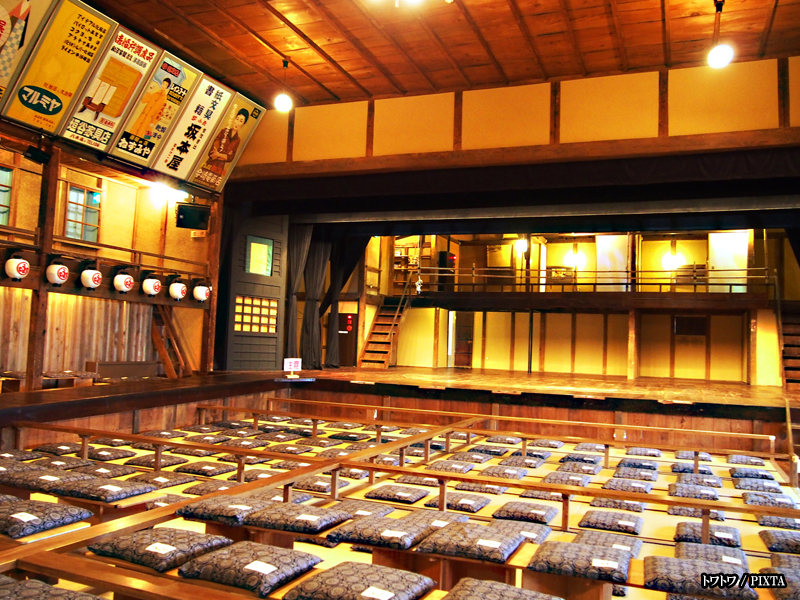
Photo for illustrative purposes
Breaking the language barrier
Many travelers worry about not understanding the language, but don’t let that deter you. Many major Kabuki theaters now offer subtitle devices! These easy-to-use handheld screens or seat-back tablets provide real-time English translations of the dialogue and scene summaries, helping you follow the plot and enjoy the performance without missing a beat. It’s a thoughtful addition that makes Kabuki more accessible and immersive for international visitors.
In addition, Shochiku, the main Kabuki producer, also offers a smartphone app with summaries, actor bios, and scene explanations. Here are the details:
English subtitles (G-marc captioning app)
- Available at: Kabukiza (Tokyo) – service began July 2024
- Notes: Tablets pre-loaded with G-marc show real-time English captions synced to the performance. Rental fee approx. 1,000 JPY. Multi-language expansion planned.
English booklets / Programs
- Available at: All major Shochiku venues
- Notes: Printed programs include plot synopsis and cast; price and details vary by production.
Cinema Kabuki “Earphone Guide” app
- Available at: iOS / Android (for Cinema Kabuki screenings and online rentals)
- Notes: Smartphone audio guide delivering plot summaries, cultural context, and scene explanations timed to the film soundtrack. App is free; per-title audio guide 500 JPY (Android) / 650 JPY (iOS). Available here.
While Kabuki theaters in Tokyo and Kyoto for tourists continue to increase their language support, it’s always wise to check in advance.
Enhancing the experience: Go beyond the show
Attending Kabuki isn’t just about watching; it’s about absorbing. Here’s how to enhance your visit beyond just watching the show.
Related article
Want to explore the art behind the curtain? Read “Inside the World of Kabuki: Costumes, Makeup, and Iconic Poses.”
Add-on experiences
- Pre-show talk sessions: Some theaters offer intro briefings (sometimes in English).
- Gallery access: The Kabukiza rooftop and lobby exhibitions are visual gems.
- Kabuki-themed souvenirs: Fans, face masks, and toy swords make quirky mementos.
Intermission culture
Bring your own bento or buy one at the theater. Bento boxes sold at Kabukiza often reflect the show’s theme, such as cherry blossom motifs in spring.
Combine it with local culture
- In Kyoto, follow your show with a Gion tea house visit.
- In Tokyo, stroll around Ginza or catch a live jazz set after the show. The district is home to several long-running jazz bars, offering a stylish contrast to Kabuki’s traditional drama.
A kabuki afternoon in Tokyo: sample itinerary
| Time | Activity |
|---|---|
| 11:00 AM | Arrive at Kabukiza and visit the rooftop garden |
| 11:45 AM | Rent subtitle device, grab a program booklet |
| 12:00 PM | Watch first act of the matinee show |
| 1:15 PM | Intermission: Eat a bento and take photos (outside) |
| 2:00 PM | Watch second act or explore Ginza shopping |
Step into the story
Watching Kabuki in Japan is more than ticking off a cultural checklist. It’s about entering a centuries-old dialogue between actor and audience, tradition and innovation, and Japan and the world. For first-time visitors, a little preparation opens the door to an unforgettable experience. You don’t need to understand every word—just bring curiosity, and a readiness to be transported.
At Umami bites, we don’t just show you Japan; we help you feel it. Whether it’s the silence before a climactic pose or the swell of music as the scene reaches its peak, there’s a seat waiting just for you.
Ready to swap Netflix for kabuki curtains and Hollywood drama for samurai showdowns? Plan your adventure today!

